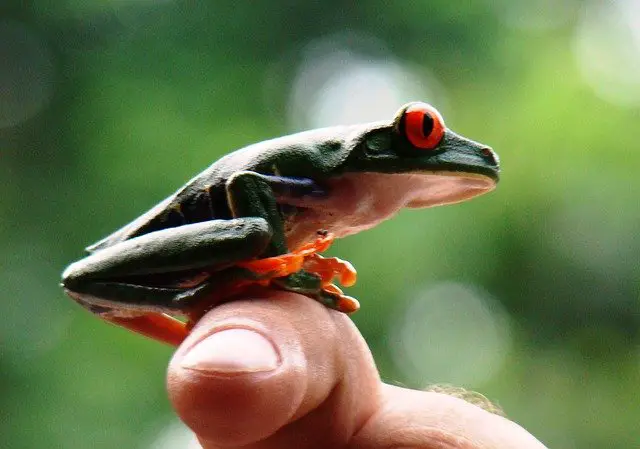Red-eyed tree frogs can eat mealworms as they contain fat, fiber, protein, and calcium. However, they should be fed infrequently and in small quantities as a supplement to your frog’s diet; otherwise, their high chitin levels may cause impaction in the frog’s gut.
Red-eyed tree frogs are carnivores and insectivores, and their primary diet in the wild would be moths, grasshoppers, flies, and even other frogs. The best food for your frog is crickets, supplemented with mealworms or wax worms now and then for variety.
Your mealworms should be raised in a sterile environment and should not be wild-caught, as they may carry pesticides, diseases, and parasites that are harmful to your frogs.
Is a Mealworm Nutritious?
Mealworms are a good source of nutrition for Red-eyed tree frogs and are safe for your frog to consume in moderation. Red-eyed tree frogs are not generally picky eaters and eat anything that moves (including other frogs.) It would help if you endeavored to vary your frog’s diet to mimic their natural opportunistic feeding patterns. A diet of only one item, such as crickets, may lead to health issues even when supplemented with calcium and vitamins.
Red-eyed tree frogs are not picky and usually eat anything that moves (including other frogs). A varied diet is recommended, as a single-item diet will be unbalanced and lead to health issues, even when adequately supplemented. Mealworms make a great addition to the variety of your red eyes diet, and live mealworms provide high protein levels for amphibians.
Mealworms are not worms but are the larval form of the Tenebrio Molitor or Mealworm Beetle, a darkling beetle species. Newly hatched mealworms are often referred to as mini-mealworms by sellers, and the average mealworm nutritional information based on a controlled diet is:
| Protein | 20.27% |
| Calcium ratio | 3.2% |
| Fat | 13 % |
| Fiber | 1.73.% |
| Ash | 1.5% |
[su_box title=”Our Tree Frog Guide “]If you are thinking about keeping red-eyed tree frogs or are an existing owner of these lovely creatures, then you might want to look at our comprehensive guide to these tree frogs. It is an absolute must. Just Click Here to have a look. Lastly, you may be interested in our guide to breeding Crickets, which will help you save money.[/su_box]
Why Can Mealworms Be Bad for My Red-Eyed Tree frog?
While being nutritious, mealworms can also be bad for your amphibians. Mealworms have a high level of chitin, a type of insect fiber. Chitin in the mealworm cuticle is indigestible and may inhibit nutrients’ absorption in the frog’s gut. The mealworm’s outer shell may not break down in your frog’s heart and create compaction that can pose deadly for your Red eyes.
Typical mealworm pupa may have up to 13% chitin content, which is relatively high compared to the standard field crickets, which only contain between 1.65% and 2.42% chitin levels. So, when feeding mealworms to your frogs, you should limit the volume and frequency of mealworms in your frog’s diet.
How Do I Feed My Red Eyed Tree Frog Mealworms?
Your mealworms provide the best nutrition if you ‘gut load’ them before feeding to your amphibians. Gut loading is a process whereby you feed your mealworms nutritious food that will be passed on to your frogs when they consume the worms. For example, by providing your worms with food high in vitamins, your frogs are ensured to absorb those nutrients along with their prey.
Because mealworms are high in fat and protein but lack many essential minerals and vitamins, they often need to be supplemented. It would help if you fed your worms top-quality organic vegetables for 12-24hrs before being provided to your Red eyes.
To ensure that your mealworms are ready to be consumed, you should place them in a tub with smooth sides with a quarter-inch of bran or cornmeal for food they require moisture as well, and you should place thinly sliced vegetables on top of your bedding, such as:
- Potatoes
- Apples
- Lettuce
- Carrots
- Collard greens
- Squash
If you intend to keep your mealworms longer for breeding purposes, you should ensure that you remove rotting fruit and vegetables from your mealworms to prevent mold. Always rotate your food items to expose them to various vitamins and minerals that make them more nutritious for your frogs.
Once they are loaded with fresh fruit and vegetables, you should dust your mealworms with calcium/D3 and multivitamin supplements. When brushing your feeder insects, ensure that you provide a dusting of calcium three times a week and calcium plus D3 twice weekly. Multivitamins can be given to your frogs once a week.
When offering your frogs mealworms, ensure that the worms are not more significant than the frog’s head and, for young frogs, no larger than a quarter-inch wide. It would help if you fed your Juveniles every day, subadults every 2-3 days, and adults 2-3 times per week.
Because Red-eyed tree frogs are nocturnal feeders, they are most active at night so feeding your mealworms at night means they will be more likely to be eaten immediately. This method ensures that your calcium/vitamin coatings are less likely to be eaten than rubbed off by the worm’s movement in the substrate.
Conclusion
Mealworms are a great way to increase the variety of foodstuffs on your tree frog’s menu, which is essential for your pets to thrive. However, care should be taken to only offer mealworms infrequently to avoid the hazards of chitin impaction. Wild-caught mealworms may be harmful, and you should purchase mealworms with a specialized diet or breed your own to ensure they are safe for your frogs to consume.




